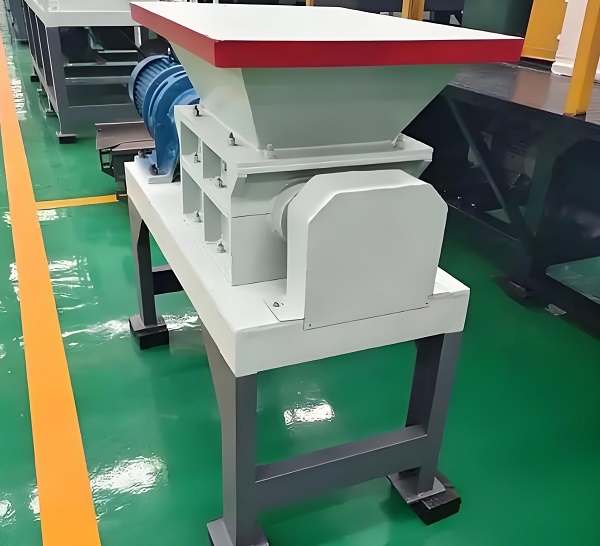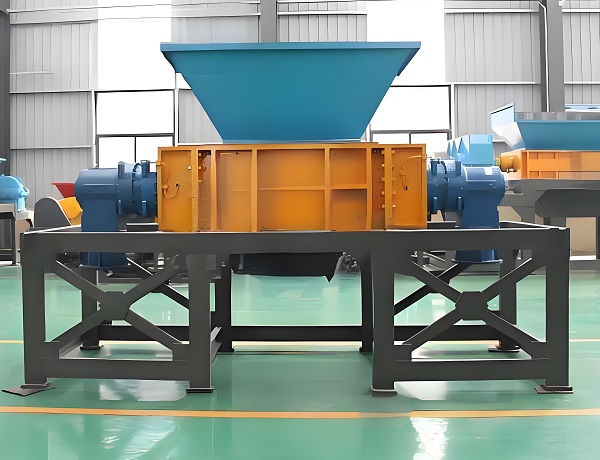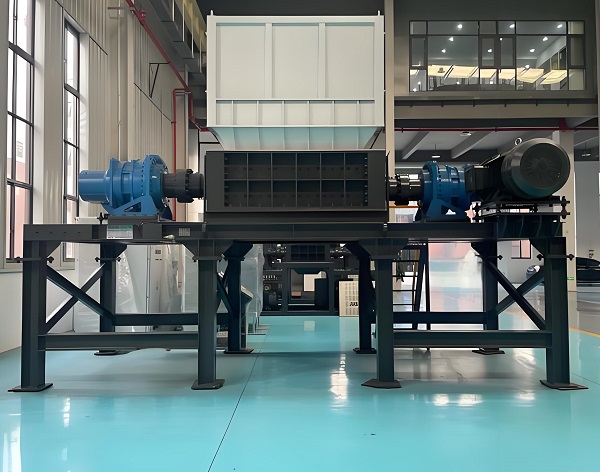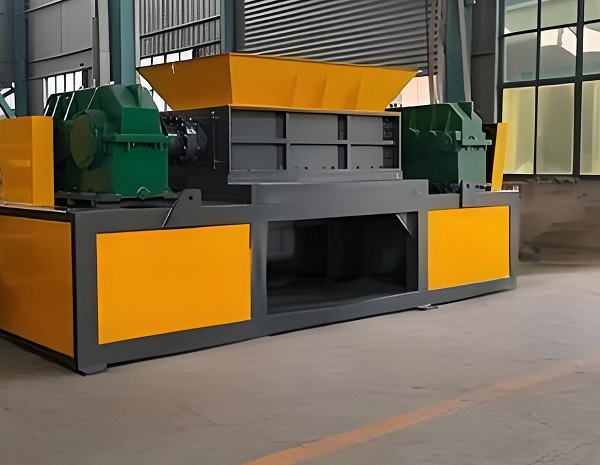The number of shafts is the most crucial factor in shredder classification, directly determining the equipment's shredding method, efficiency, and applicable materials. Mainstream models on the market include single-shaft, dual-shaft, and quad-shaft shredders, with multi-shaft shredders (five or more shafts) also being used in some applications.
In the industrial shredding and solid waste treatment sectors, single-shaft and multi-shaft shredders offer distinct performance advantages and application scenarios due to their structural differences. Single-shaft shredders, with their "single main shaft + fixed blade" design, focus on specific material processing. Multi-shaft shredders (including dual-shaft and quad-shaft shredders) leverage the synergy of multiple shafts to accommodate more complex shredding needs. Together, they cover shredding operations across diverse sectors.
1.Single-Shaft Shredder

A single-shaft shredder features a core structure consisting of a single rotating spindle and fixed blades. The spindle is equipped with spirally arranged rotating blades, while the inner casing houses interlocking fixed blades. The high-speed spindle rotation (typically 50-150 rpm) shreds the material through the shearing and tearing action of the rotating and fixed blades. A built-in pusher continuously propels the material toward the blades to prevent jamming.
Its core features are as follows:
Material Adaptability Focuses on "Toughness/Flexibility": It excels at handling tough, entangled materials such as plastic film, woven bags, waste fabric, and rubber hoses. Multi-shaft shredders are prone to entanglement with the spindle, but the spiral blades of a single-shaft shredder utilize a combination of gradual shearing and directional feeding to quickly shred entangled materials and prevent equipment jams. Highly Uniform Crushed Particles: Because the gap between the moving and fixed blades can be precisely adjusted (typically within 1-5mm) and the main shaft speed is stable, the crushed material produces highly consistent particle size, making it suitable for applications requiring high crushing precision, such as the pre-processing step of direct granulation after crushing in plastic recycling.
Simple Structure and Low Maintenance Cost: The single-shaft design reduces the complexity of the transmission system, requiring only maintenance on the bearings and cutting tools of a single main shaft. The cutting tools are made of removable alloy, requiring only partial replacement of the cutting head when worn, rather than the entire blade. This reduces maintenance time and costs by 30%-50% compared to multi-shaft systems.
Significant Limitations: The crushing force is weak and cannot handle hard materials (such as metal blocks and stone). Furthermore, efficiency is low when handling large, high-density materials (such as large plastic barrels and discarded furniture), and downtime is easily caused by material "stuck" in the pusher mechanism.
2.Twin-Shaft Shredder

Twin-shaft shredders are currently the most widely used type. Their core structure consists of two parallel, counter-rotating main shafts, each equipped with staggered blades. The blades of the two shafts interlock (similar to scissors). The shearing, squeezing, and tearing forces generated by the slow rotation of the main shafts (typically 20-60 rpm) shred the material. A screen at the bottom of the device controls the particle size of the shredded material.
The twin-shaft shredder's core features are as follows:
Its wide adaptability encompasses both soft and hard materials: It can handle both low- and medium-hard materials like plastics, rubber, and paper, as well as small metal parts (such as cans and tin boxes), wood waste (such as used pallets and branches), and electronic waste (such as old phone cases and circuit boards). It can even handle materials with high moisture content (such as food waste and sludge cakes), making it the preferred equipment for one-stop shredding. Balanced Crushing Efficiency and Force: The counter-rotating dual shafts generate a "biting pull" that quickly grabs material and pulls it into the crushing chamber, preventing accumulation at the inlet. The lower rotation speed (compared to a single shaft) reduces speed but increases torque, making it easy to crush plastic sheets up to 50mm thick or metal pipes up to 100mm in diameter. The shredder's throughput is typically 1.5-3 times that of a single-shaft shredder (for example, the 1000 dual-shaft shredder can process 8-15 tons of material per hour).
Strong Overload Resistance: The device features built-in overload protection systems (such as a hydraulic pusher and current overload protection). When encountering difficult-to-crush hard objects (such as metal lumps mixed in the material), the main shaft automatically stops or reverses, preventing damage to the cutters and motor. Some models also feature an automatic blade cleaning function to reduce material sticking to the cutter assembly. Limitations: Particle uniformity is slightly inferior to single-shaft models (due to gap fluctuations in the interlocking mechanism). When processing tough, easily entangled materials (such as plastic film), some entanglement may occur, requiring a pre-cutting device.
3. Four-Shaft Shredder

A four-shaft shredder incorporates two auxiliary spindles, creating a "two-tiered" blade structure. The upper spindle is responsible for "coarse crushing," shearing large pieces of material into medium-sized pieces, while the lower spindle is responsible for "fine crushing," further reducing the material to the required particle size. The overall speed is lower (10-40 rpm) and the torque is higher.
Its core features are as follows:
Specializing in "large, hard, and complex materials": It is a core equipment for processing large solid waste, such as used automobile shells, large tires, container boards, and used machine tool parts. This type of material is bulky and hard, making it difficult for a two-shaft shredder to shred it all at once. However, the four-shaft shredder's "layered crushing" design allows for gradual material breakdown. The upper blade group first shears the car shell into 10-20cm pieces, while the lower blade group crushes them into 5-10cm particles, preventing damage to the equipment due to excessive force applied all at once.
The crushing size is highly controllable: By adjusting the gap between the upper and lower blade groups and the aperture of the bottom screen, a continuous "coarse crushing, medium crushing, and fine crushing" process can be achieved. The output particle size can be controlled between 1 and 30mm, meeting different subsequent processing needs (e.g., shredding scrap tires for rubber pellets, or shredding car shells for metal recycling and sorting).
High operational stability and low noise: The four-shaft structure distributes the forces during the crushing process, preventing excessive pressure on a single main shaft. The vibration amplitude during operation is over 40% lower than that of a two-shaft machine, and noise levels are controlled below 85 decibels (compared to 95-105 decibels for a two-shaft machine), making it suitable for plants with strict environmental requirements.
Limitations: The machine is large (typically requiring 1.5-2 times the floor space of a two-shaft machine) and heavy (large four-shaft machines can weigh up to 10-20 tons), requiring high load-bearing capacity and space requirements for the installation site. Both initial purchase and ongoing maintenance costs are higher than those of single- and two-shaft models (for example, tool replacement costs are approximately 1.8 times that of a two-shaft machine). Therefore, it is only suitable for large-scale, high-load crushing applications.
4. Multi-axis shredders (five or more axes)

Multi-axis shredders are custom-designed for specific materials. For example, five-axis shredders are often used for crushing large, irregularly shaped materials (such as large fiberglass products and scrapped yacht hulls), while six-axis shredders are used for high-precision crushing applications (such as the harmless disposal of medical waste and hazardous waste). Their core features are multi-dimensional force distribution and seamless crushing. Through the coordinated rotation of multiple main axes, they grasp and crush irregular materials from different directions, preventing them from becoming stuck in the corners of the crushing chamber. However, due to their complex structure and extremely high cost (typically 2-3 times that of a four-axis shredder), their application range is limited, limited to specialized industrial applications.
Single-axis shredders utilize a single main axis with a fixed blade. They excel at processing tough/flexible materials, producing uniform particles, a simple structure, and low maintenance. However, they lack force and struggle to shred hard and bulky materials. Multi-axis (double-axis, quad-axis, etc.) relies on multi-axis engagement. Double-axis has a wide adaptability and a balance between efficiency and force. Quad-axis specializes in large, high-hardness materials and has strong stability. However, multi-axis equipment has a complex structure and high cost, and has higher requirements for site and budget.
Save Time! Get A Detailed Quotation Quickly.
